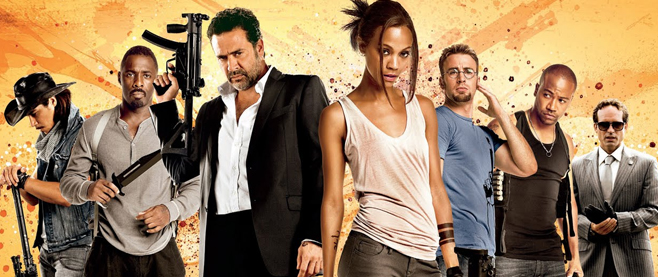
Who Deserves the Future?
“Should we return to silence?”
In the final moments of Kingdom of the Planet of the Apes, this question is asked by protagonist Noa of one of the last remaining humans, Mae. The film’s central conflict revolves around the contentious ownership of a vault containing the last vestiges of humanity’s technology and weaponry, and indeed whether anyone should lay claim to it. Mae is determined to wrest this dangling thread of connection to the old world from the grip of the burgeoning ape civilization, insistent that earth belongs to humankind.
The Planet of the Apes saga, particularly the modern films beginning with Matt Reeve’s Rise of the Planet of the Apes, documents a clearly-drawn Promethean tale, a parable of man’s overreach causing their own destruction, hastened by their inherent warlike flailing as human populations begin to dwindle. The slow reversal of fortunes between humans and apes and our shifting sympathies are reinforced by the films’ groundbreaking digital effects and facial animation, particularly from the unparalleled performance of Caesar by Andy Serkis. Each new installment brings the empathy of the ape protagonists further to the forefront, without just turning them into furry humans. Despite this apparent effort to bring us into the apes’ psyches and accept their transition into the dominant species, Kingdom of the Planet of the Apes highlights the lack of conviction from which post-apocalyptic stories often suffer, in their insistence in constantly refocusing on humanity’s story. While the apes continue to learn and grow, they will always be in contention with humanity, which must always have some inherent presence on earth.
The towering ruins of human civilization which backdrop much of the film share a striking similarity to those in 2017’s Horizon: Zero Dawn, and which would go on to serve as a defining feature of that game’s imagery. Horizon’s post-apocalyptic USA is littered with simple human settlements, with small, tribal structures, living in symbiosis with, and in the shadow of, impossibly sophisticated robotic creatures. Like Planet of the Apes, Horizon details a story of mankind’s downfall in the wake of hubristic technological overreach, with the notably familiar MacGuffin of hoards of preserved human innovation, trapped within impenetrable underground vaults. In Horizon’s world the moral question of humanity’s persistence is somewhat averted by pinning all the world’s evils on one specific man, Ted Faro. Not only is he the cause of the robot plague which ravages earth to begin with, but he also wipes out the archives of collected human knowledge which had been preserved in the hopes that future humans might use it to rebuild something of the old earth. Even with this, the blankest of slates from which humanity could rise again, the narrative and world design are completely interwoven with messages and relics of the past. The AI program HADES, designed to reset the entire biosphere to zero if terraforming attempts were found to be heading down a dead end, has intervened three times prior to the start of Zero Dawn, and still the rusted skeletons of old skyscrapers loom over Aloy throughout her journey. So why are we so insistent on looking back? Is it a lack of imagination, or an unshakeable desire to tell stories which we can relate back to the world around us?

This trope can be seen in microcosm in the post-credits scene of the original Final Fantasy 7, in which Red XIII, a member of a leonid species, is seen overlooking the ruins of humanity, alongside his partner and offspring as the apparent inheritors of a new world. Birdsong is heard, a flock of geese fly overhead, and the sprawling metropolis of Midgar is smothered by greenery. While I love this original ending, which seems to highlight the game’s environmental messages surrounding the persistence of life in spite of human exploitation, it is undercut in its dying moments, as the screen fades to black, and the sound of laughing children is heard, just for a few seconds. This final note, suggesting the continuation of human life somewhere is ambiguous, and apparently optimistic – but perhaps a little toothless.
A different Square Enix game would go much further down this rabbit hole. At the outset Nier: Automata appears to be following many of the post-apocalyptic tropes. A race of manufactured, sentient androids is defending and securing Earth for the eventual return of mankind to its rightful place while humanity sits dormant and waiting on the Moon. Those ever-symbolic, moss-covered ruins of skyscrapers still litter the landscape, a constant reminder of the world that was, and that one day might be again.
If, like me and many others, you hadn’t played the original Nier game, you wouldn’t know that humanity has in fact long been extinct. The androids were fighting on behalf of a fabricated cohort of surviving humans purely to motivate them to continue fighting against an invasion of extraterrestrial machines. It eventually transpires that the machines’ creators are also long-since gone, and that these two factions are caught in an endless conflict over the fading scraps of a dead society. Here, then, we have the rare opportunity to actually explore what a post-human earth might look like – and yet it isn’t really taken. The machines begin mimicking what they can find from the remains of humanity, its culture and philosophy, while the androids, all but human in appearance, tear themselves apart when the grand deception of their purpose is revealed. The true ending of the game leaves Earth’s fate uncertain, yet it seems any future will be indelibly shaped by the imprint of humans. For a series as consistently interested in the eternal perseverance of memory, this is perhaps a fitting conclusion, and while the Nier games do follow these human-centric post-apocalyptic tropes, they at least seem to understand their inescapability.
The ubiquity of this narrative structure is perhaps unsurprising – how interesting would a truly post-apocalyptic story really be? Without some allusions to the world that was lost, Earth would surely be indistinguishable from an alien planet. Perhaps, then, Nier’s approach is the key to making these settings richer, and giving them more of a unique identity. Rather than following pockets of surviving humans, clinging on through grit and ingenuity, and trying to rebuild some version of early 21st-century society, instead show us what might be born from the ashes of that society instead.
The 2016 film The Girl with All the Gifts shows how the most well-trodden post-apocalyptic setting can achieve just this. While zombies are typically used as heavy-handed metaphors for various aspects of modern-day life – rampant consumerism or the inherent, dormant monstrousness of man – this film does something arguably more interesting. The film’s titular girl is Melanie, one of a new generation born within a fungal zombie plague, with the ability to think, feel and learn. While it becomes increasingly clear that humanity’s downfall is inevitable, the closing moments show Melanie leading this new generation as the dominant species on Earth, with her human teacher Helen spending her final moments educating these new pioneers from behind an airlocked door. In doing so, she gives them the best chance of creating something new, and perhaps even better than what came before.
The ending is surprisingly hopeful, and if it does say anything about modern society, it’s the importance of relinquishing and preserving the world for new generations, even though you won’t live to see the wonders of their eventual new world yourself. Perhaps that should be the takeaway of those laughing voices soundtracking the ruins of Final Fantasy 7’s world. We’ll never see the owners of those voices, or know how they live – we can only imagine.
———
Jonathan is a biological researcher by day, but spends much of the rest of his time obsessing over games, music and music in games. You can follow him on Bluesky and at Medium.




